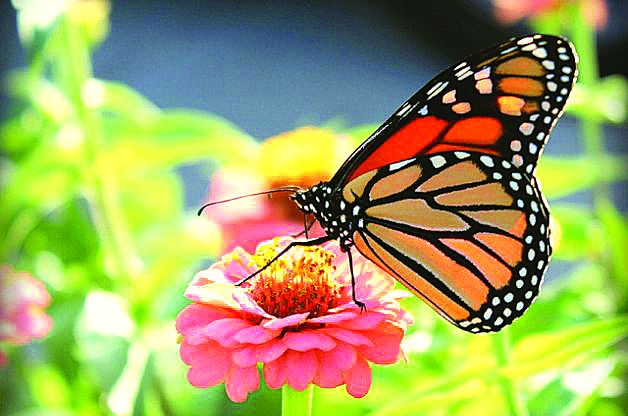By Lori Murray, Cameron County Master Gardener, Texas Superstar Specialist
One of the most fascinating aspects of nature is the metamorphosis some caterpillars make to become butterflies. Elementary school teachers sometimes provide their students with a peek at this miracle by housing the caterpillar, the chrysalis, and ultimately the butterfly itself in their classrooms. But monarch butterflies have one even more astounding characteristic: over the course of four generations and a year in time, they migrate across continents.
Each of the first three generations lives only two to six weeks, lays its eggs, and reproduces along the migration route, but those of the fourth generation – the one born in September or October – live eight or nine months and travel thousands of miles south to spend the winter months in a warmer habitat. Why is the fourth generation the only one that does that? No one knows.
Monarchs that spend their summer in western North America fly to southern California. Those who summer in eastern North America migrate to the Sierra Madre Mountains of central Mexico and come right through the Valley. Some travel 2,000 miles or more, riding thermal currents and flying as fast as 25 miles per hour. Unfortunately, the monarchs’ population has dropped by 90% over the past several years. In human population terms, that’s the equivalent of losing every person in the U.S. except for those in Florida and Ohio! (www.aqua.org/monarchs) That’s why it’s so important that we provide milkweed and other habitat to help our beautiful Monarchs build up their numbers.
One of the actions we here in the Valley can take is to create “way stations” that provide the essentials for monarchs’ survival. (see www.Monarch Watch.org for order information and to download a guide in PDF format) The website suggests a hundred square feet, but any space will do.
I turned a spare flower bed of about 50 square feet in the backyard into a butterfly garden that, unlike my previous efforts, would provide more than nectar plants. In researching, I found that it was possible to order seeds for some of the important plants, but in putting together my own butterfly garden, I became much more interested in using plants I could find right here at home. The following two-part article by Mary Beth Simmons outlines (1) what can be done locally to turn space we have in our own yards into a habitat garden and (2) what plants we can grow easily right here in the RGV.




